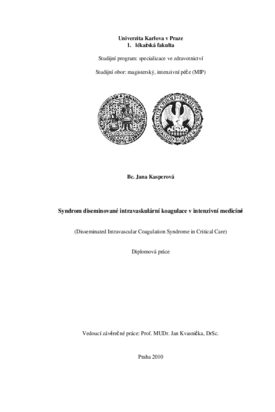Syndrom diseminované intravaskulární koagulace v intenzivní medicíně
Disseminated Intravascular Coagulation Syndrome in Critical Care
diplomová práce (OBHÁJENO)

Zobrazit/
Trvalý odkaz
http://hdl.handle.net/20.500.11956/27387Identifikátory
SIS: 81970
Kolekce
- Kvalifikační práce [4458]
Autor
Vedoucí práce
Oponent práce
Krška, Zdeněk
Fakulta / součást
1. lékařská fakulta
Obor
Intenzivní péče
Katedra / ústav / klinika
Ústav teorie a praxe ošetřovatelství 1. LF UK v Praze
Datum obhajoby
24. 6. 2010
Nakladatel
Univerzita Karlova. 1. lékařská fakultaJazyk
Čeština
Známka
Výborně
Diplomová práce se zabývá problematikou syndromu diseminované intravaskulární koagulace (DIC) v intenzivní medicíně. Teoretická část poskytuje informace o epidemiologii, patofyziologii, etiologii, klinické klasifikaci a diagnostice syndromu diseminované intravaskulární koagulace a shrnuje možnosti léčby tohoto patologického procesu. Praktická část informuje o výsledcích výzkumu zaměřeného na určení patologických stavů, které vyvolaly syndrom DIC, analýzu vývoje vybraných hematologických parametrů v čase, stanovení míry korelace vybraných veličin a ověření správnosti diagnostiky syndromu DIC dle ISTH kritérií pro stanovení diagnózy DIC u souboru 29 pacientů se syndromem DIC hospitalizovaných ve Všeobecné fakultní nemocnici v Praze v letech 2006 až 2009. Výsledky výzkumu potvrzují hypotézy, že se hemokoagulační nález syndromu DIC nebude zásadně lišit pohlavím ani věkem, že mortalita pacientů, u nichž vznikla akutní forma syndromu DIC na podkladě sepse, bude minimálně 50 % a že korelace mezi věkem, pohlavím pacientů se syndromem DIC a hematologickými parametry nebude statisticky významná. Naopak hypotéza, že u všech pacientů s akutní formou DIC bude počet trombocytů menší nebo roven 100 x 109 /l, INR větší nebo rovno 1,2, aPTT delší než 40 sec, hladina fibrinogenu menší než 2 g/l a že bude více než dvojnásobně...
We have conducted a retrospective study on disseminated intravascular coagulation syndrome (DIC) in critical care. The theoretical part of the study focusses on the epidemiology, pathogenesis, ethiology, clinical features, laboratory diagnosis, differential diagnosis, and medical complications of the disseminated intravascular coagulation syndrome, and describes the major therapeutic approaches. The aim of this study is to determine the etiology and outcome of the treatment of 29 patients hospitalized because of a DIC diagnosis in General University Hospital in Prague between January 2006 and December 2009, to analyse the changes of the laboratory test values over time, to see if there is any correlation between the chosen variables, and to assess confidence in the diagnosis of DIC according to the ISTH criteria for the diagnosis of DIC. The hypotheses that there will not be a significant difference between the gender, age and the laboratory values of DIC patients, that the mortality of septic patients with DIC will be a minimum of 50 %, and that the correlation between age, gender and the laboratory values in DIC patients will not be significant, were confirmed. On the contrary, the hypothese that the platelet count of all the DIC patients will be smaller or equal to 100 x 109 /l, prothrombin time (INR)...
